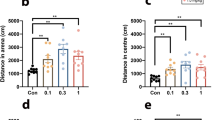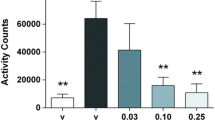Abstract
Rationale
Systemic injection of the non-competitive NMDA (N-methyl-d-aspartate) receptor antagonist MK-801 (dizocilpine maleate) causes both increased locomotion in rodents and various stereotypic behaviors that are proposed to model certain aspects of schizophrenic symptoms in humans.
Objectives
This study presents a comprehensive characterization of the bimodal effects of MK-801 on locomotion and stereotypy in the C57BL/6 mouse strain, a strain commonly used for genetically modified mice.
Results
We found that it is important to analyze both locomotion and stereotypy in parallel, as MK-801-induced stereotypy results in abnormal movements that are recorded as locomotion by automated beam detection systems. Furthermore, it is important to analyze the bimodal effects of MK-801 over an extended time span, rather than the commonly used narrower time window, as at higher doses (e.g., above 0.3 mg/kg) the hyperlocomotion phase develops only after the stereotypic phase subsides. We also observed that the apparent dose–response curve is very sensitive to the particular time window chosen for analysis because MK-801 affects both the time course and maximum value of stimulated locomotion. We show that analyzing the absolute peak value of locomotion induced for each animal, rather than group-averaged time courses, provides a measure that is sensitive over a wider range of MK-801 doses. Interestingly, MK-801 even at a very low dose of 0.02 mg/kg suppressed rather than enhanced rearing behavior, differing in this regard from amphetamine.
Conclusions
The non-competitive NMDA receptor antagonist MK-801 induces a complex pattern of behavioral modification in mice with respect to both the time course and the dose–response relationship of behavioral changes. The results of this study provide a foundation and frame of reference for the growing interest in studying MK-801-induced behavior in mice.






Similar content being viewed by others
References
Adriani W, Felici A, Sargolini F, Roullet P, Usiello A, Oliverio A, Mele A (1998) N-methyl-d-aspartate and dopamine receptor involvement in the modulation of locomotor activity and memory processes. Exp Brain Res 123:52–59
Amador M, Dani JA (1991) MK-801 inhibition of nicotinic acetylcholine receptor channels. Synapse 7:207–215
Cabib S, Puglisi-Allegra S, Oliverio A (1984) Chronic stress enhances apomorphine-induced stereotyped behavior in mice: involvement of endogenous opioids. Brain Res 298:138–140
Carlsson M, Carlsson A (1989) The NMDA antagonist MK-801 causes marked locomotor stimulation in monoamine-depleted mice. J Neural Transm 75:221–226
Carlsson M, Carlsson A (1990) Interactions between glutamatergic and monoaminergic systems within the basal ganglia—implications for schizophrenia and Parkinson’s disease. Trends Neuro Sci 13:272–276
Carlsson A, Waters N, Carlsson ML (1999) Neurotransmitter interactions in schizophrenia—therapeutic implications. Biol Psychiatry 46:1388–1395
Clineschmidt BV, Martin GE, Bunting PR, Papp NL (1982) Central sympathomimetic activity of (+)-5-methyl-10,11-dihydro- 5H-dibenzo [d]cyclohepten-5, 10-immine(MK-801), a substance with potent anticonvulsant, central sympathomimetic, and apparent anxiolytic properties. Drug Dev Res 2:135–145
Deutsch SI, Rosse RB, Mastropaolo J (1997) Behavioral approaches to the functional assessment of NMDA-mediated neural transmission in intact mice. Clin Neuropharmacol 20:375–384
Florin S, Suaudeau C, Meunier JC, Costentin J (1997) Orphan neuropeptide NocII, a putative pronociceptin maturation product, stimulates locomotion in mice. Neuroreport 8:705–707
Geter-Douglass B, Witkin JM (1999) Behavioral effects and anticonvulsant efficacies of low-affinity, uncompetitive NMDA antagonists in mice. Psychopharmacology 146:280–289
Harkin A, Morris K, Kelly JP, O’Donnell JM, Leonard BE (2001) Modulation of MK-801-induced behaviour by noradrenergic agents in mice. Psychopharmacology 154:177–188
Institute of Laboratory Animal Resources (1996) Guide for the care and use of laboratory animals. National Academy Press, Washington
Javitt DC (1987) Negative schizophrenic symptomatology and the PCP (phencyclidine) model of schizophrenia. Hillside J Clin Psychiatry 9:12–35
Kaplan GB, Greenblatt DJ, Kent MA, Cotreau MM, Arcelin G, Shader RI (1992) Caffeine-induced behavioral stimulation is dose-dependent and associated with A1 adenosine receptor occupancy. Neuropsychopharmacology 6:145–153
Kim JS, Kornhuber HH, Schmid-Burgk W, Holzmuller B (1980) Low cerebrospinal fluid glutamate in schizophrenic patients and a new hypothesis on schizophrenia. Neurosci Lett 20:379–382
Koyuncuoglu H, Kara I, Gunel MA, Nurten A, Yamanturk P (1998) N-methyl-d-aspartate antagonists, glutamate release inhibitors, 4-aminopyridine at neuromuscular transmission. Pharmacol Res 37:485–491
Lat J (1973) The analysis of habituation. Acta Neurobiol Exp 33:771–789
Liljequist S, Ossowska K, Grabowska-Anden M, Anden NE (1991) Effect of the NMDA receptor antagonist, MK-801, on locomotor activity and on the metabolism of dopamine in various brain areas of mice. Eur J Pharmacol 195:55–61
Malomuzh AI, Mukhtarov MR, Urazaev AK, Nikol’skii EE, Vyskochil F (2002) The effects of glutamate on spontaneous acetylcholine secretion processes in the rat neuromuscular synapse. Neurosci Behav Physiol 32:577–582
Masuo Y, Noguchi J, Morita S, Matsumoto Y (1995) Effects of intracerebroventricular administration of pituitary adenylate cyclase-activating polypeptide (PACAP) on the motor activity and reserpine-induced hypothermia in murines. Brain Res 700:219–226
Miyamoto M, Narumi S, Nagai Y, Saji Y, Nagawa Y (1984) A TRH analog (DN-1417): motor stimulation with rearing related to catecholaminergic mechanisms in rats. Neuropharmacology 23:61–72
Moghaddam B (2003) Bringing order to the glutamate chaos in schizophrenia. Neuron 40:881–884
O’Neill MF, Shaw G (1999) Comparison of dopamine receptor antagonists on hyperlocomotion induced by cocaine, amphetamine, MK-801 and the dopamine D1 agonist C-APB in mice. Psychopharmacology 145:237–250
Ramoa AS, Alkondon M, Aracava Y, Irons J, Lunt GG, Deshpande SS, Wonnacott S, Aronstam RS, Albuquerque EX (1990) The anticonvulsant MK-801 interacts with peripheral and central nicotinic acetylcholine receptor ion channels. J Pharmacol Exp Ther 254:71–82
Randrup A, Munkvad I (1974) Pharmacology and physiology of stereotyped behavior. J Psychiatr Res 11:1–10
Randrup A, Munkvad I (1975) Stereotyped behavior. Pharmacol Ther [B] 1:757–768
Rukoyatkina NI, Gorbunova LV, Gmiro VE, Lukomskaya NY (2003) The ability of new non-competitive glutamate receptor blockers to weaken motor disorders in animals. Neurosci Behav Physiol 33:273–278
Smoothy R, Berry MS (1985) Time course of the locomotor stimulant and depressant effects of a single low dose of ethanol in mice. Psychopharmacology 85:57–61
Tiedtke PI, Bischoff C, Schmidt WJ (1990) MK-801-induced stereotypy and its antagonism by neuroleptic drugs. J Neural Transm Gen Sect 81:173–182
Young R, Darmani NA, Elder EL, Dumas D, Glennon RA (1997) Clobenzorex: evidence for amphetamine-like behavioral actions. Pharmacol Biochem Behav 56:311–316
Acknowledgments
This work was supported in part by National Natural Science Foundation of China (30270219) and National Institutes of Health (USA) grants (DA09444, DA13471, and DA12848). We thank Johanna Meij, Ning Guo, Lingyan Wang, Cheng Ding, and Yuanjia Tang for helpful comments. The experiments reported herein comply with the current laws of the People’s Republic of China and the United States of America.
Author information
Authors and Affiliations
Corresponding author
Additional information
The first three authors contributed equally to this work.
Co-corresponding authors: Guoping Zhao, Meilei Jin, Lei Yu
Rights and permissions
About this article
Cite this article
Wu, J., Zou, H., Strong, J.A. et al. Bimodal effects of MK-801 on locomotion and stereotypy in C57BL/6 mice. Psychopharmacology 177, 256–263 (2005). https://doi.org/10.1007/s00213-004-1944-1
Received:
Accepted:
Published:
Issue Date:
DOI: https://doi.org/10.1007/s00213-004-1944-1




